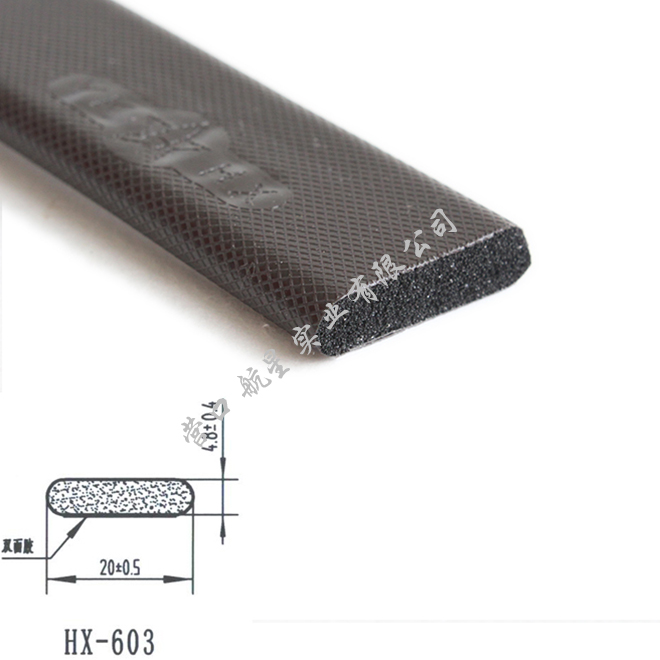There are three types of rubber materials for automotive seals: dense rubber, sponge rubber, and hard rubber. Hard rubber hardness up to Shaw A95. The rubber compound of the sealing strip is more resistant to aging, low temperature, water and gas, and chemical resistance, especially EPDM that is resistant to ozone aging. EPDM can be compounded with steel belt, steel wire braid, TPE, flannel, flocking, PU coating, silicone coating, etc. to ensure the waterproof, dustproof, soundproof, heat insulation, vibration reduction, and anti-dust of the interior and exterior of the automobile. Grinding and decorative effects. Under normal circumstances, EPDM seal can be used stably for more than ten years. Also available are chloroprene rubber (CR) with good ozone resistance and good aging resistance. Taking into account the technical properties of commonly used rubber materials, it is sometimes necessary to choose and use rubbers such as natural rubber (NR) and CR and styrene butadiene rubber (SBR) rubbers or polyethylene (PE), EPDM and NR rubber and plastics. Improve ozone resistance. With the continuous development and maturation of thermoplastic elastomer (TPE) technology, the field of application is expanding. Among the raw materials used to make the seals, EPDM, the main raw material used in the past, is constantly being updated and developed. The new EPDM, which has excellent physical properties and good processability, can control long-chain branching in molecules to make it more vulcanized and increase the extrusion speed and product yield. New thermoplastic elastomers such as TPO and TPV are also increasingly used in automotive seals. These materials not only have the excellent engineering properties of elastomers, but also have the excellent properties of plastics, which are not only convenient for processing but also can be recycled for reuse. These materials are gradually replacing EPDM products.
(1) Discontinuous vulcanization method (after the extrusion tape is cut to a certain length, it is put into the vulcanization tank for vulcanization, and the semi-finished product of the extruded tape is put into the model for vulcanization);
(2) continuous vulcanization method (microwave continuous vulcanization method, salt bath continuous vulcanization method, hot air continuous vulcanization method and several other methods). A. Microwave continuous vulcanization composite seals: Microwave vulcanization technology is a production technology that has been widely applied after the foreign energy crisis in the 1970s. Using microwave continuous vulcanization technology can not only produce composite strips made of metal core, solid core rubber and sponge glue, but also is superior to other continuous vulcanization devices in terms of energy saving and work efficiency improvement. This technology is recognized by the world as the best process for producing extruded products. The characteristic of microwave heating is that heat is generated directly in the heated object instead of being input from the outside like conventionally. This not only generates heat quickly but also has a uniform distribution, which helps to improve product quality and shortens the time for heating. B. Salt bath continuous vulcanization seal: The salt bath cures using a nitrite-containing salt bath system, which is environmentally polluted and has gradually been eliminated. C. Hot Air Vulcanized Sealing Strips: Hot Air Sulfur has now been developed to strong wind curing

Can be divided into solid core products (round, square, flat cross-sectional shape), hollow products and metal rubber composite products and other types. Among them, metal rubber composite seals account for more than 60%. Cross section design is critical for rubber seals. The first is the shape and size of the sealing lip, and the sealing lips on both sides should contact the glass from both sides of the window glass with the same force of the proper size. The length and thickness of the lip should be appropriate. Too thick and too long will increase the resistance of the glass. Too thin and too short will lead to poor guidance and sealing of the glass, resulting in vibration, noise, and leakage of the rain. The shape and size of the bottom of the section are designed. There are projections on the steel channel section of the window. Its function is to assemble the guide groove. Therefore, the bottom of the guide groove section should be designed with a corresponding structure, which is easy to load and can use the elasticity of the sealing strip itself. Adhere to the steel guide groove to prevent it from coming out; Finally, the outer edge of the shape, size, in order to improve the appearance of the guide groove outside the surface should be closely with the body.